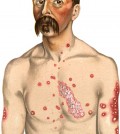- Psoriasis Cure: Great Alternatives To Standard Medical Treatments
- The Top 5 Nutrients To Include In Your Psoriasis Diet
- Skin Conditions: 8 Different Types Of Psoriasis
- Psoriasis Symptoms And The Various Treatments Available
- Scratching The Truth Behind Psoriasis And Psoriasis Causes
- Guttate Psoriasis: What Is It And How To Get Rid Of It?
- Why Should You Use An Eczema Cream?
- Which Eczema Treatment Should You Choose?
- What Is The Best Psoriasis Treatment?
- How To Treat Scalp Psoriasis Effectively?
What Is The Best Psoriasis Treatment?
Before talking about a psoriasis treatment, let’s have a look at what psoriasis is first. An autoimmune disease, psoriasis is a non-contagious disease that affects the skin cells. The problem happens when the skin cells start to grow faster, causing irregularities on the skin.
Although the main cause of this problem is not clear, different forms of a psoriasis treatment have already been introduced to the public.
There are five types of psoriasis: guttate, inverse, erythrodermic, plaque and pustular. Treatments for this autoimmune problem have two goals: stop the abnormal production of skin cells while smoothing the surface to bring back the natural texture.
Topical Treatments
Topical are those that are directly applied to the skin like lotions and cream. One of the most common and can be bought almost anywhere is salicylic acid which reduces scaling of the skin. Moisturizers are also recommended although they don’t really interrupt the process of skin cells production.
However, moisturizers manage to make the condition more bearable by reducing the itchiness and the dryness of the skin. Vitamin D or ointments rich in vitamin D have also been found to be effective since they manage to hinder the skin cells from multiplying while a medication called Anthralin is said to normalize the production of cells.
Usually, Anthralin is used together with light therapy treatment while the others mentioned are best used by those suffering from mild psoriasis.

Light Therapy
Light therapy is the exposure of the skin to different levels of light. The most common is sunlight or more specifically, the use of ultraviolet light coming from the sun. When UV hits the skin, it manages to kill the active skin cells which then trigger the replacement process. When done at light and quick intervals, sunlight exposure is a good psoriasis.
However, too much exposure can lead to the worsening of the condition.
A moderate psoriasis condition may also be controlled using UVB which usually comes from an artificial light source.
This psoriasis treatment is often used for conditions that do not respond well to topical treatments – regardless of it being within a controlled body part or spread all over the skin. However, the treatment itself can lead to red and itchy skin albeit a temporary side effect.
An improvisation on the UVB treatment is Narrowband UVB Therapy which is done three times a week and can improve the condition of the skin.
Once the skin starts showing signs of health, Narrowband UVB may then be minimized to one time per week although side effects may include severe burns.
Injections or Oral Treatment
For those who are struggling with severe psoriasis, then it is up to the doctors to prescribe more powerful drugs. This may be in the form of pills or injected directly to the body and will only be provided for a short period of time due to the side effects.
For the benefit of the patient, using oral drugs for psoriasis is constantly monitored by the doctor because of the severity of the side effects. For example, a drug prescribed to psoriasis patients would require them not to get pregnant for the next three years because it can cause defects during birth.
Of course, regardless of what the treatment is, consulting the doctor is always the best way to go.
Last but not least, there exist many alternative creams and solutions, I have written a review about Dermasis here.










One Comment